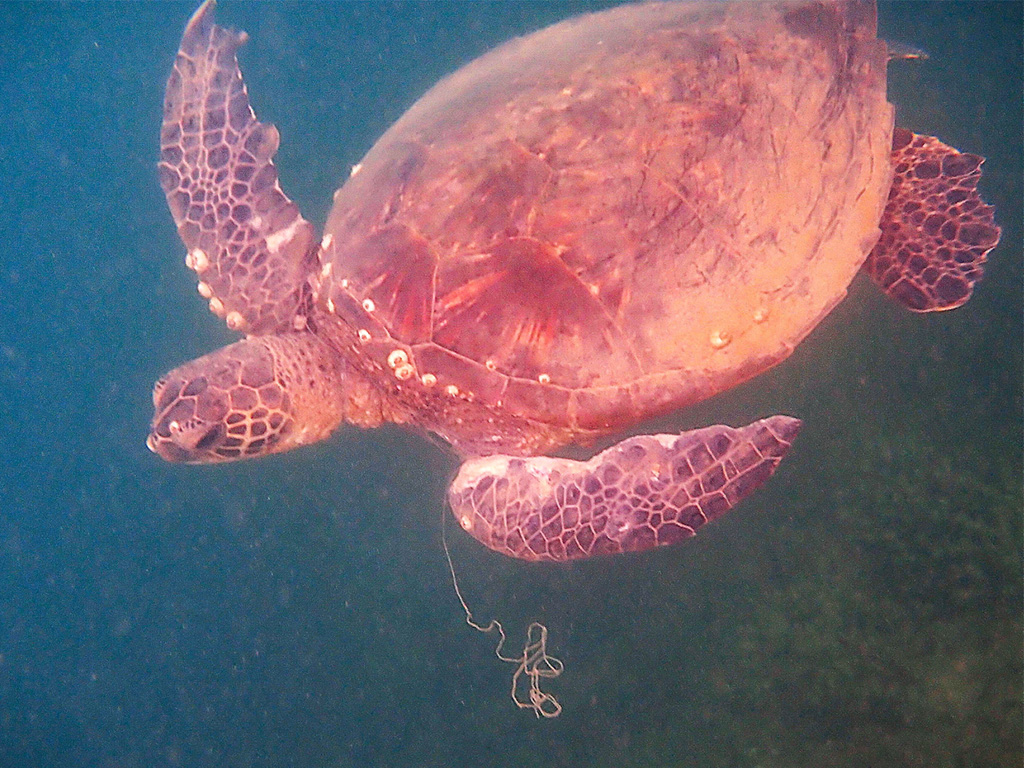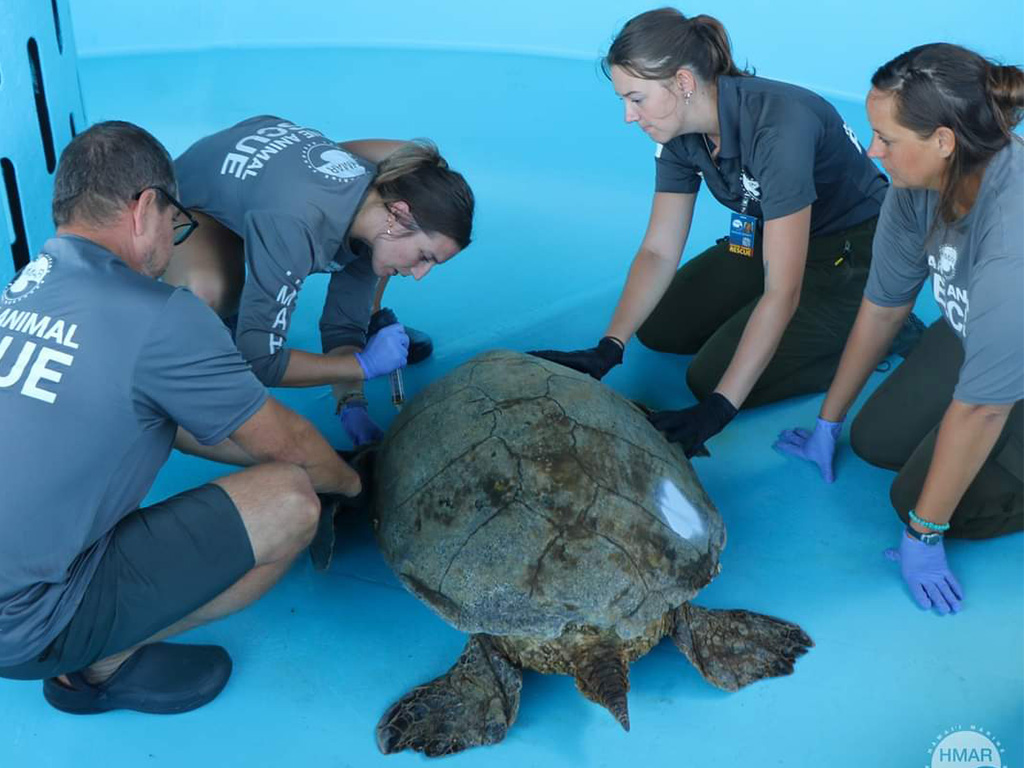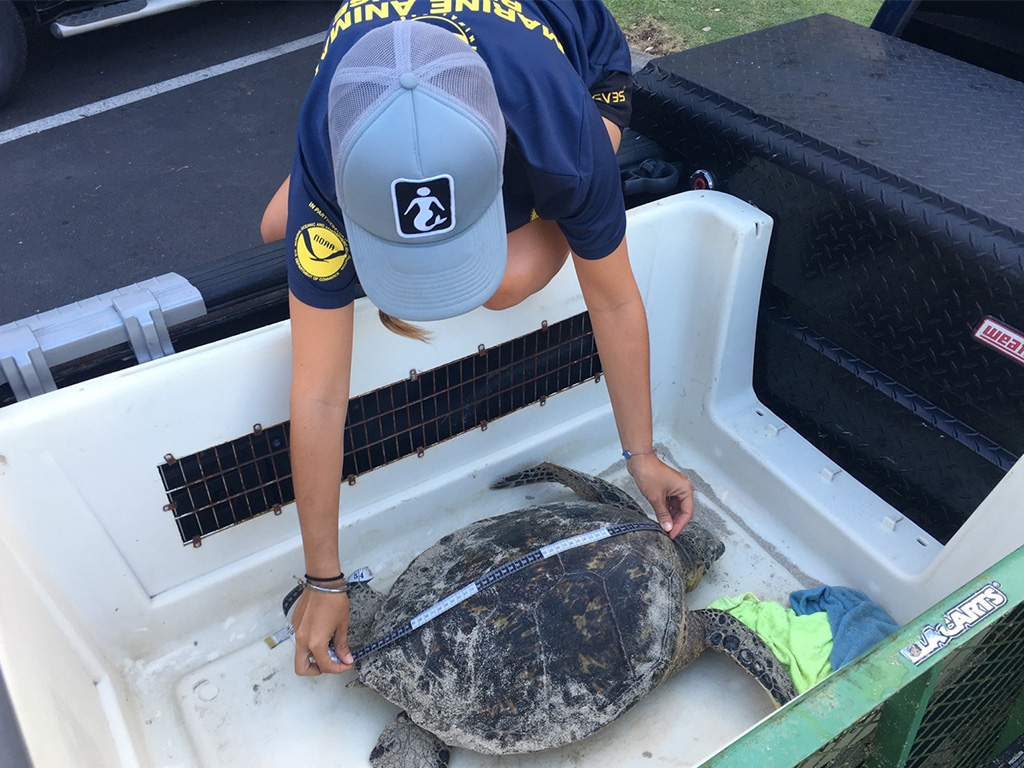
A green sea turtle in Kaneohe Bay that has a monofilament fishing line entangled on its front left flipper.
New research at HPU reveals that entanglement in monofilament fishing gear is now the leading cause of injury in stranded Hawaiian green sea turtles (honu), a threatened species. A stranded sea turtle is any turtle found on land or in the water that is dead, injured, or exhibits any indication of ill health or abnormal behavior. From 2010 to 2019, fibropapillomatosis disease was the most common stressor among stranded honu, accounting for 25% of cases, followed by fishing lines (22%), hooks (8%), shark predation (5%), boat strikes (5%), and net entanglements (3%). However, since 2016, fishing gear-related strandings have surged, surpassing fibropapillomatosis as the primary threat to honu in Hawaiʻi.

HMAR team members work to rehabilitate a green sea turtle. Image By Jon D. Gelman, HMAR
Thin, nearly invisible strands of fishing line accumulate on reefs and in nearshore waters across the state, posing a threat to marine life and ecosystems. Due to high human population density and related high coastal fishing pressure plus abundant shoreline access, Oʻahu is the primary hotspot for hook and line-induced trauma. Researchers believe this increase is likely driven by both the growing honu population and expanded fishing activities, creating a higher overlap between honu and coastal fishing activity.
“The source of these nylon monofilament fishing lines are from fishers casting from shore or trolling from boats in nearshore waters,” said Jennifer Lynch, Ph.D., a biologist with the National Institute of Standards and Technology (NIST) and co-director of the HPU Center for Marine Debris Research (CMDR). “It is unfortunate that our activities result in this damaging plastic pollution and collide with the survival of marine species. Society should take additional steps to prevent this problem while also continuing to remove it and rescue the turtles that are harmed by it.”
The new research article, published in Marine Pollution Bulletin titled, “Marine debris impacts on Hawaiian green sea turtles (Chelonia mydas): High prevalence of hook-and-line fishing gear in strandings,” highlights how fishing line entanglement has become the primary stranding threat to honu. Research, led by scientists from multiple organizations, analyzed over 10,300 strandings between 1982 and 2024 and found that fishing line entanglements have increased over time, accounting for more than 30% of strandings annually in recent years.
The article, co-authored by Lynch, Marthe Høiberg, Francesca Verones, Jan Borgelt, and Philip Mostert from the Norwegian University of Science and Technology (NTNU), Shawn Murakawa and Summer Martin from NOAA’s Pacific Islands Fisheries Science Center, and Jon Gelman from Hawai‘i Marine Animal Response (HMAR), analyzed 40 years of stranding data for Hawaiian green sea turtles. Together, they identified that fishing line-induced strandings have increased over time and have been the primary anthropogenic stranding threat to honu since 2016. Høiberg and Verones both came to HPU as international exchanges for several months and were important contributors to this research.
Notably, turtles affected by fishing lines have a higher chance of survival if rescued promptly, underscoring the importance of stranding response and marine debris clean-up efforts.

HMAR team member measures a green sea turtle. Image By NOAA Fisheries, Pacific Island Region
In-water marine debris clean-up dives led by HMAR detail the scale of the problem. Since 2019, HMAR has measured and logged large amounts of marine debris collected during in-water clean-up activities from 137 events, revealing how monofilament lines accumulate on Oahu’s reefs, damaging coral habitats and posing significant risks to marine life. Over the past three years, more than 17,000 meters of fishing line have been collected, which is the equivalent of over 10½ miles of fishing line removed from Oʻahu reefs by HMAR alone (noting that other organizations also undertake reef cleanup activities).
Each organization plays a pivotal role in addressing this pressing issue.
NTNU researchers contributed advanced spatial modeling techniques to predict areas of high fishing line accumulation. NOAA’s Pacific Islands Fisheries Science Center provided decades of stranding data and facilitated collaboration with local response networks. HMAR’s targeted debris clean-ups and response efforts have been critical in responding to and rescuing entangled turtles. NIST and HPU’s CMDR have been instrumental in analyzing debris composition and promoting public awareness through community engagement.
Adding to these efforts, HPU recently partnered with HMAR to open a sea turtle emergency care and rehabilitation facility on O‘ahu. The facility, HMAR Care Center, located at HPU’s Makapu‘u Campus, began operations in September 2024 and admitted its first patients in early-November 2024. The Center provides critical care to O‘ahu turtles found injured by fishing gear and other threats. Supported by a grant from the National Fish and Wildlife Foundation, the center helps rehabilitate sea turtles and offers valuable opportunities for research, education, and internships for HPU students.
Timely intervention is critical for improving survival rates among entangled honu. Many turtles affected by fishing lines are found alive, with survival rates significantly increasing through prompt in-field response. Research indicates that turtles with hook injuries have an 86% survival rate, while those entangled in lines have a 64% survival rate, highlighting the impact of immediate action. Line entanglement is one of the most harmful threats turtles face, making conservation measures—such as assistance from fishers, public reporting, and rapid response by trained professionals—essential for their protection.
How to Help
If fishers accidentally catch a turtle NOAA advises to immediately call the NOAA Marine Animal Hotline at 888-256-9840 for guidance. This may include cutting the line as close to the hook as possible to prevent turtle entanglement.
There are multiple fishing line recycling programs and receptacles placed throughout Hawai‘i, including programs in Maui, Hawai'i Island, Honolulu, and Kauaʻi. Fishermen are urged to be cautious and not lose gear, and to dispose of gear responsibly.
To learn more about NOAA’s tips for fishing around sea turtles, click here.
To learn more about research being done at HPU’s CMDR, visit www.hpu.edu/cmdr.


